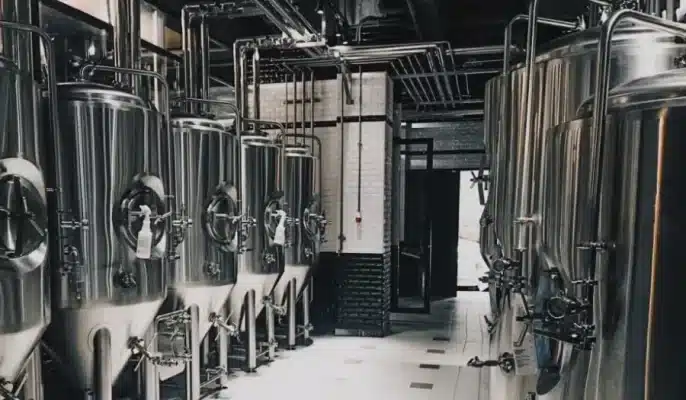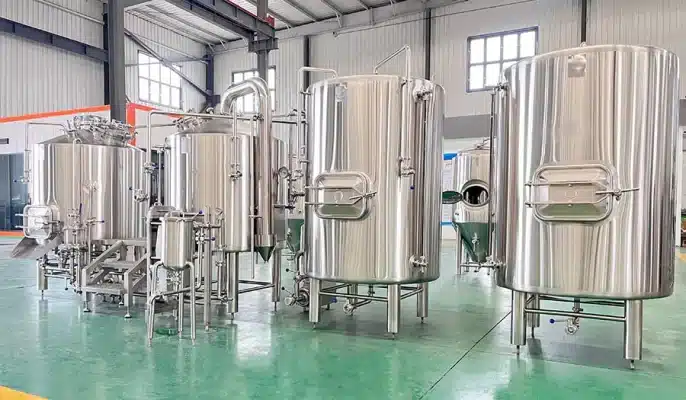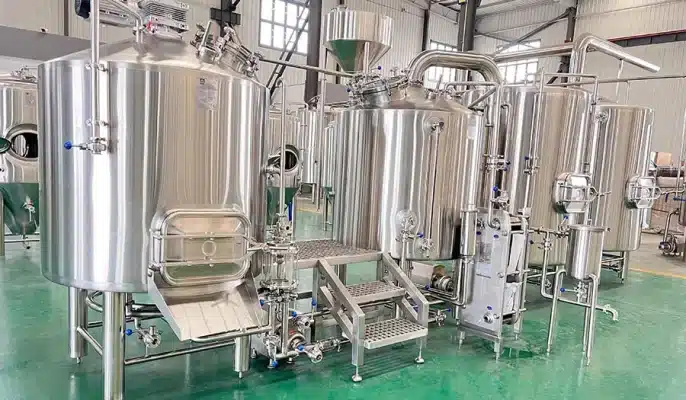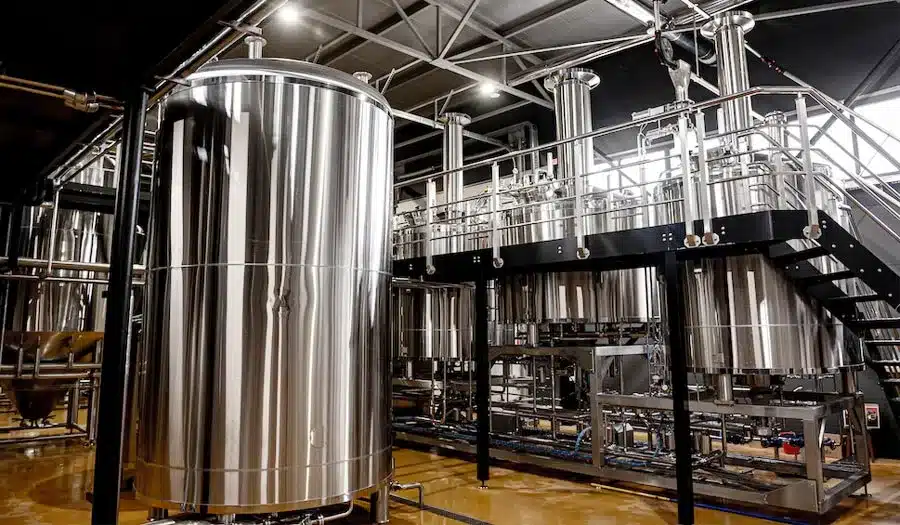Whether you are a beginner or an experienced home brewer, finding a brewing kettle that suits your needs is essential to brewing delicious beer. Choosing a suitable brewing kettle is one of the key steps in every brewing process. In this guide, this article will analyze the types, features, and buying guides of brewing kettles in detail to help you choose the brewing kettle that best suits your needs.
What is a brew kettle?
A brew kettle is a container used to brew beer, usually made of materials such as stainless steel, aluminum alloy, or glass. Its design usually includes a pot body, heating elements (or heat sources), temperature control systems, and other related accessories. A brew kettle is an essential piece of equipment for any homebrewer. It is used to heat water and dissolve malt extracts, hops, and other ingredients to produce wort, which is the basis of all beer. Brew kettles come in various sizes, shapes, and materials and can be used for all-grain and extract brewing.
The most basic brew kettle is a simple kettle with a lid and a single tap. This type of kettle is often used for extracts and is great for beginners. It is usually made of stainless steel, aluminum, or copper and is relatively inexpensive. The basic steps of beer brewing include mash, boiling, fermentation, etc., each of which requires the help of a brew kettle. Different brew kettles have different designs and functions, which can help brewers better control temperature, time, and other parameters to brew beer with rich taste and unique flavor.

The role of the brew kettle in beer brewing
During the brewing process, raw materials such as water, malt, hops, and yeast are mixed in a brew kettle. The kettle is then heated to bring the mixture to a boil.
- Sterilization: Boiling the raw materials helps kill any bacteria or wild yeast present in the mixture, ensuring a clean fermentation process. This step is essential to prevent off-flavors and maintain the quality of the beer.
- Enzyme activation: Boiling activates enzymes in the malt, promoting the conversion of starch into fermentable sugars. This process is called saccharification and is essential for providing the yeast with the nutrients it needs to produce alcohol.
- Hop utilization: Boiling extracts the bitterness, flavor, and aroma of hops, balancing the sweetness of the malt. The length of time the hops are boiled can greatly affect the final taste of the beer.
Types of beer brewing kettles
Stainless steel brewing kettles
Stainless steel is currently the most common material for beer brewing kettles. Due to their excellent corrosion resistance, high-temperature resistance, and easy cleaning, stainless steel brewing kettles have been widely used in home brewing. Stainless steel can effectively avoid the reaction of acidic substances and ensure the stability of the taste and flavor of beer.
Aluminum alloy brewing kettles
Aluminum alloy brewing kettles are lighter, have better thermal conductivity, and are usually cheaper than stainless steel kettles. Therefore, aluminum alloy brewing kettles are a good choice for some beginners or home brewers with limited budgets. However, the corrosion resistance of aluminum alloys is relatively poor, and brewers need to clean and maintain them carefully after use.
Glass brewing kettles
Glass brewing kettles are mainly used in the fermentation process. Since the glass material does not react with the ingredients in the beer, it can retain the original flavor of the beer to the maximum extent. Although the heat resistance and strength of the glass kettle are not as good as those of metal materials, it provides a clearer observation field during the fermentation process, and the brewer can check the fermentation situation at any time.
Multifunctional brewing kettles
With the development of beer brewing technology, more and more brewing kettles are equipped with multifunctional designs. These brewing kettles usually integrate multiple functions such as mash, boiling, cooling, and fermentation, which can greatly simplify the brewing process and accurately control temperature, time, etc. This type of brewing kettle is usually suitable for experienced brewers or users who want to manage the brewing process in a refined manner.
Small and large brewing kettles
Depending on the capacity, beer brewing kettles can be divided into small and large categories. Small brewing kettles are usually suitable for home brewing, with a capacity of about 5 to 10 liters, which is very suitable for beginners to experiment and small batch production. Large brewing kettles are suitable for brewing workshops or brewing enthusiasts of a certain scale, and the capacity can reach dozens of liters or even larger.

Different types of beer brewing kettles
- Traditional Stainless Steel: These kettles are durable, easy to clean, and able to withstand high temperatures. They are a popular choice among homebrewers and professionals alike. Featuring a sleek and timeless design, the stainless steel kettle is not only functional but also adds a touch of elegance to any brewing setup.
- Electric Brewing System: These kettles use electricity to heat liquid, providing precise temperature control without the need for an external heat source. Electric brewing systems are favored by winemakers who value convenience and accuracy. Able to set and maintain specific temperatures, these kettles provide an unparalleled level of control.
- Electromagnetic induction brewing system: The electromagnetic induction kettle uses electromagnetic heating to heat quickly and efficiently. They are known to be energy efficient and are an environmentally friendly choice. Induction kettles are especially popular among professional brewers who need to heat large amounts of liquid quickly.
- Gas burner kettles: These kettles rely on a gas burner or propane burner to heat liquids. They are often favored by homebrewers because they are portable and affordable. The flexibility of a gas burner kettle allows brewers to take their brewing adventures outdoors or in different locations.
How to Choose the Best Brew Kettle?
Material Selection
The material of a brew kettle plays an important role in the brewing process and the flavor of the beer. The two most popular materials for brew kettles are stainless steel and copper. Stainless steel kettles are known for being durable, corrosion-resistant, and easy to clean. They also have excellent heat retention properties, ensuring a consistent temperature during the brewing process. Stainless steel kettles are favored by many brewers for their ability to brew pure-tasting beer.
Copper kettles are highly regarded for their excellent thermal conductivity. Copper conducts heat quickly and evenly, making it ideal for achieving precise temperature control. In addition, copper can interact with brewing ingredients to add subtle flavors and aromas to beer. However, it should be noted that copper kettles require regular cleaning and maintenance to prevent tarnishing.
Size and Capacity
The size and capacity of a brew kettle are important factors that brewers of all levels need to consider. The right size kettle will provide enough space for your ingredients and leave enough room for boiling without overflowing. If you are just starting or like to brew smaller batches, a kettle with a capacity of 5 to 10 gallons should be sufficient. However, if you are an experienced brewer or plan to brew a large amount of beer, you may need a kettle with a capacity of 15 gallons or more. If you want to brew on a large scale or produce multiple batches, you can choose a large brewing kettle of 20 liters and above.
Functions and additional accessories
With the advancement of technology, some beer brewing kettles have been equipped with a variety of functions, such as temperature control, automatic stirring, cooling systems, etc. These additional functions can help brewers better control each brewing link and improve the quality of beer.
Some high-end beer brewing kettles are also equipped with intelligent control systems, which can be connected to smart devices through an APP to monitor the brewing process in real-time. This can provide more convenience and precise operation for experienced brewers.
Budget and price
Different types of beer brewing kettles have different prices. Generally, stainless steel brewing kettles are more expensive, while aluminum alloy kettles and plastic kettles are relatively cheap. It is recommended to choose a suitable brewing kettle according to your budget. If you are just starting to try home brewing, you can choose small equipment with high-cost performance; if you plan to brew for a long time, you can invest in a high-quality multi-functional brewing kettle.
Cleaning and maintenance
Hygiene in the beer brewing process is very critical, and any microbial contamination may affect the quality of the beer. Therefore, it is important to choose a brew kettle that is easy to clean and maintain. It is best to choose a material with a smooth surface that does not easily harbor dirt and dirt and make sure that all parts of the brew kettle can be easily disassembled and cleaned.

FAQ
What is a beer brewing kettle?
A beer brewing kettle is a device specially used for home brewing, which is usually used for heating, boiling, saccharifying, and cooling malt liquid. It can help brewers better control the brewing process and ensure the quality of beer.
How should the capacity of a beer brewing kettle be selected?
The capacity of a beer brewing kettle is usually between 5 liters and 50 liters. The capacity of a home brewing kettle is usually between 10-20 liters. If you are a beginner, it is recommended to choose a smaller-capacity kettle. The capacity of 5-10 liters can not only meet the needs of the family but also facilitate the mastering of brewing skills. If your brewing needs are large or you want to brew multiple batches, you can consider a larger capacity equipment.
Can you mash the malt in the brewing pot?
You can mash in the brewing pot. This is the process of mixing grains with hot water to allow enzymes to break down starch and convert it into fermentable sugars. This is an important step in the beer brewing process, and the brewing kettle is the perfect container to complete this step.
Is the electric kettle worth buying?
For those who want to save time and energy, electric kettles are a good choice. They are more efficient than traditional kettles because they heat the water faster. This means you can brew beer faster and with less effort.




